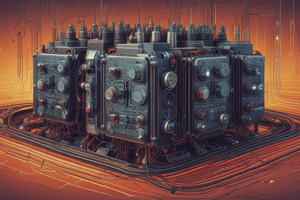Podcast
Questions and Answers
What is the primary goal of system analysis?
What is the primary goal of system analysis?
- To solely identify user requirements.
- To create a new or improved system that meets user needs. (correct)
- To abandon existing systems entirely.
- To develop software without user input.
Which phase of system analysis involves collecting data about the existing system's operations?
Which phase of system analysis involves collecting data about the existing system's operations?
- Evaluation
- Implementation
- System Design
- Information Gathering (correct)
What technique is characterized by breaking a system down into smaller components?
What technique is characterized by breaking a system down into smaller components?
- Use Case Analysis
- Rapid Prototyping
- Object-oriented Analysis
- Structured Analysis (correct)
Which phase follows System Analysis in the process of system analysis?
Which phase follows System Analysis in the process of system analysis?
What is the purpose of the Testing phase in system analysis?
What is the purpose of the Testing phase in system analysis?
Which analysis technique describes interactions between users and the system?
Which analysis technique describes interactions between users and the system?
In which phase are the system's architecture and interfaces defined?
In which phase are the system's architecture and interfaces defined?
What is an essential ongoing process after a system is implemented?
What is an essential ongoing process after a system is implemented?
What do Data Flow Diagrams (DFDs) primarily illustrate?
What do Data Flow Diagrams (DFDs) primarily illustrate?
What is one benefit of system analysis?
What is one benefit of system analysis?
Which tool is NOT typically used in system analysis?
Which tool is NOT typically used in system analysis?
What challenge is often faced during system analysis?
What challenge is often faced during system analysis?
What is the purpose of Process Modeling in system analysis?
What is the purpose of Process Modeling in system analysis?
How does system analysis improve data quality?
How does system analysis improve data quality?
Which is a potential consequence of inadequate data quality during system analysis?
Which is a potential consequence of inadequate data quality during system analysis?
What is an example of a benefit derived from enhanced user satisfaction through system analysis?
What is an example of a benefit derived from enhanced user satisfaction through system analysis?
Flashcards
System Analysis
System Analysis
A process of studying an existing system to understand, evaluate, and improve its efficiency and effectiveness in addressing user needs.
Problem Definition
Problem Definition
The first step in system analysis, where the specific problem the system needs to address is clearly identified and understood.
Information Gathering
Information Gathering
Collecting data about the existing system's operations, user requirements, and constraints.
System Analysis
System Analysis
Signup and view all the flashcards
System Design
System Design
Signup and view all the flashcards
Structured Analysis
Structured Analysis
Signup and view all the flashcards
Object-oriented Analysis
Object-oriented Analysis
Signup and view all the flashcards
Use Case Analysis
Use Case Analysis
Signup and view all the flashcards
Data Flow Diagram (DFD)
Data Flow Diagram (DFD)
Signup and view all the flashcards
Entity-Relationship Diagram (ERD)
Entity-Relationship Diagram (ERD)
Signup and view all the flashcards
Process Modeling
Process Modeling
Signup and view all the flashcards
What are the benefits of system analysis?
What are the benefits of system analysis?
Signup and view all the flashcards
What is a common challenge in system analysis?
What is a common challenge in system analysis?
Signup and view all the flashcards
What is user resistance to change?
What is user resistance to change?
Signup and view all the flashcards
What are some tools used in system analysis?
What are some tools used in system analysis?
Signup and view all the flashcards
Why is consistency crucial in system analysis?
Why is consistency crucial in system analysis?
Signup and view all the flashcards
Study Notes
Introduction to System Analysis
- System analysis is a process of studying an existing system to identify problems, evaluate its effectiveness, and make recommendations for improvements.
- This process involves gathering information about the system, identifying its components and relationships, and analyzing its strengths and weaknesses.
- The ultimate goal is to build a new or improved system that effectively addresses user needs in a more efficient manner.
- Key aspects include understanding business processes, data flows, and user interactions within the system.
Key Phases in System Analysis
- Problem Definition: Clearly define the problem the system needs to solve, encompassing the current state of the organization and its users.
- Information Gathering: Collect data on the existing system's operations, user requirements, and limitations. Techniques include interviews, questionnaires, observation, and document analysis.
- System Analysis: Identify issues and opportunities, document processes, evaluate alternatives, design solutions, and select the best options.
- This includes identifying problems and their impact, documenting data flow within the system, and defining goals and objectives.
- System Design: Create a detailed blueprint for the new system, specifying its architecture, data structures, and interfaces.
- Implementation: Develop and test the new system, including data migration and training users.
- Testing: Ensure the system meets its requirements and specifications.
- Evaluation: Assess the system's performance, user experience, and overall effectiveness.
- Maintenance: Provide ongoing support and updates to keep the system functional and meet evolving user needs.
System Analysis Techniques
- Structured Analysis: Evaluate a system by breaking it into smaller, manageable components and defining their relationships. Tools like Data Flow Diagrams (DFDs) and Entity-Relationship Diagrams (ERDs) are used.
- Object-oriented Analysis: Focus on objects and their interactions, modeling components as objects with data and methods.
- Use Case Analysis: Describe interactions between users and the system using use cases, highlighting functionalities for each user role.
- Data Flow Diagrams (DFDs): Visual representations of data movement, showing inputs, processes, and outputs.
- Entity-Relationship Diagrams (ERDs): Visual models of system entities (objects) and their relationships.
- Process Modeling: Illustrate how different system parts work together to complete a task.
System Analysis Tools and Technologies
- Tools aid the system analysis process, streamlining data collection and interpretation.
- These include modelling software for creating DFDs, ERDs, etc., databases for data storage, statistical tools for data analysis, business process modeling tools, and prototyping tools for creating interactive system mock-ups.
Benefits of System Analysis
- Enhanced Efficiency: Streamlined processes and elimination of redundancies lead to reduced resource use and time.
- Increased Productivity: Optimized workflows and better resource allocation improve productivity levels.
- Improved User Satisfaction: Customized systems enhance user experience, satisfaction, and engagement.
- Reduced Costs: Identifying inefficiencies and waste through analysis helps decrease overall costs.
- Better Decision-Making: Streamlined access to reliable data and improved support systems aid strategic choices.
- Improved Data Quality: Accurate, reliable, and consistent data directly improves system performance and analysis.
Challenges in System Analysis
- Complex Systems: Difficulty in fully understanding intricate structures.
- User Resistance to Change: Resistance to implementing new systems or processes from employees.
- Evolving User Needs: Keeping pace with changing user needs and technological advancements.
- Time and Budget Constraints: Common issues during system analysis.
- Data Quality Issues: Erroneous analyses due to poor data quality.
- Maintaining Consistency: Ensuring consistency throughout the design and development process.
Conclusion
- System analysis is essential for creating effective and efficient systems, enhancing functionality and operation within organizations.
- Understanding techniques, tools, and challenges is key for successful new or revised system implementation.
Studying That Suits You
Use AI to generate personalized quizzes and flashcards to suit your learning preferences.




